The Cambridge History of China. Vol. 12: Republican China, 1912-1949, Part 1
Подождите немного. Документ загружается.

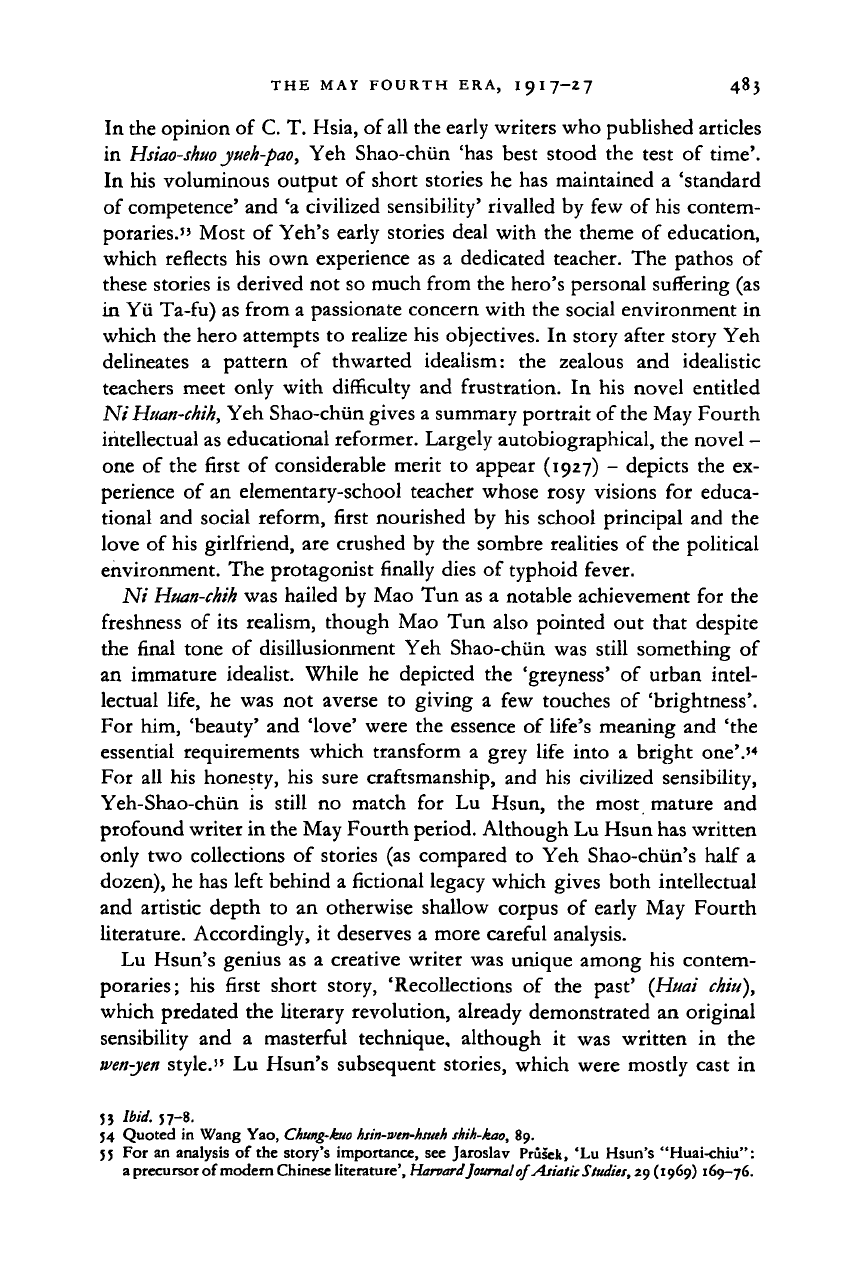
THE MAY FOURTH ERA, 1917-27 483
In the opinion of C. T. Hsia, of
all
the early writers who published articles
in
Hsiao-shuo
yueh-pao,
Yeh Shao-chiin 'has best stood the test of time'.
In his voluminous output of short stories he has maintained a 'standard
of competence' and 'a civilized sensibility' rivalled by few of his contem-
poraries." Most of Yeh's early stories deal with the theme of education,
which reflects his own experience as a dedicated teacher. The pathos of
these stories is derived not so much from the hero's personal suffering (as
in Yii Ta-fu) as from a passionate concern with the social environment in
which the hero attempts to realize his objectives. In story after story Yeh
delineates a pattern of thwarted idealism: the zealous and idealistic
teachers meet only with difficulty and frustration. In his novel entitled
Ni
Huan-chih,
Yeh Shao-chiin gives a summary portrait of the May Fourth
intellectual as educational reformer. Largely autobiographical, the novel -
one of the first of considerable merit to appear (1927) - depicts the ex-
perience of an elementary-school teacher whose rosy visions for educa-
tional and social reform, first nourished by his school principal and the
love of his girlfriend, are crushed by the sombre realities of the political
environment. The protagonist finally dies of typhoid fever.
Ni
Huan-chih
was hailed by Mao Tun as a notable achievement for the
freshness of its realism, though Mao Tun also pointed out that despite
the final tone of disillusionment Yeh Shao-chun was still something of
an immature idealist. While he depicted the 'greyness' of urban intel-
lectual life, he was not averse to giving a few touches of 'brightness'.
For him, 'beauty' and 'love' were the essence of life's meaning and 'the
essential requirements which transform a grey life into a bright one'.'
4
For all his honesty, his sure craftsmanship, and his civilized sensibility,
Yeh-Shao-chiin is still no match for Lu Hsun, the most mature and
profound writer in the May Fourth period. Although Lu Hsun has written
only two collections of stories (as compared to Yeh Shao-chiin's half a
dozen),
he has left behind a fictional legacy which gives both intellectual
and artistic depth to an otherwise shallow corpus of early May Fourth
literature. Accordingly, it deserves a more careful analysis.
Lu Hsun's genius as a creative writer was unique among his contem-
poraries; his first short story, 'Recollections of the past' (Huai chiu),
which predated the literary revolution, already demonstrated an original
sensibility and a masterful technique, although it was written in the
wen-yen
style." Lu Hsun's subsequent stories, which were mostly cast in
53
Ibid. 57-8.
54
Quoted in Wang Yao,
Chung-kuo hsin-wen-htuth
shih-kao,
89.
55
For an analysis of the story's
importance,
see Jaroslav Prusek, 'Lu Hsun's
"Huai-chiu":
a precursor of modern
Chinese
literature',
Harvard Journal oj Asiatic
Studies,
29 (1969)
169-76.
Cambridge Histories Online © Cambridge University Press, 2008
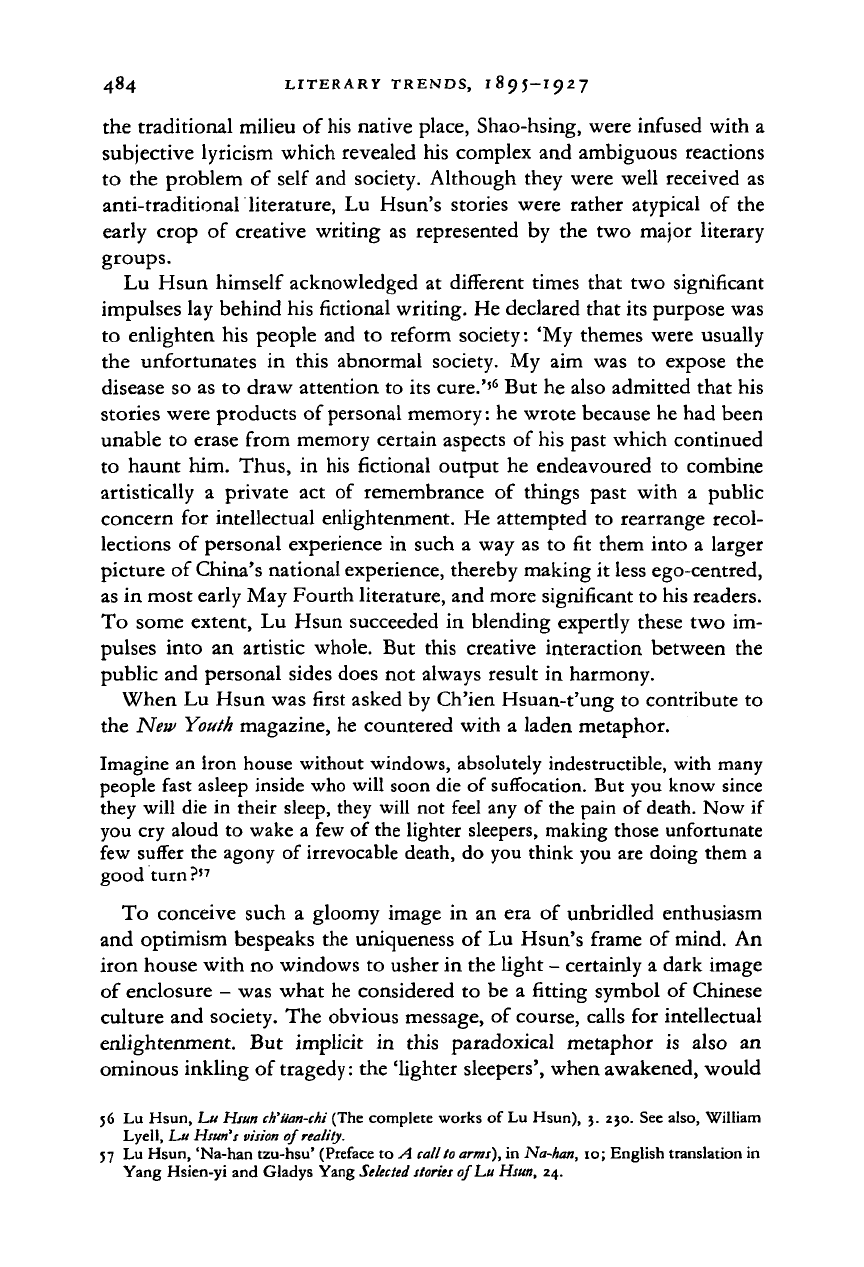
484 LITERARY TRENDS, 1895-I927
the traditional milieu of
his
native place, Shao-hsing, were infused with a
subjective lyricism which revealed his complex and ambiguous reactions
to the problem
of
self and society. Although they were well received as
anti-traditional literature, Lu Hsun's stories were rather atypical
of
the
early crop
of
creative writing as represented by the two major literary
groups.
Lu Hsun himself acknowledged
at
different times that two significant
impulses lay behind his fictional writing. He declared that its purpose was
to enlighten his people and
to
reform society: 'My themes were usually
the unfortunates
in
this abnormal society. My aim was
to
expose
the
disease so as to draw attention to its cure.''
6
But he also admitted that his
stories were products of personal memory: he wrote because he had been
unable to erase from memory certain aspects of his past which continued
to haunt him. Thus,
in
his fictional output he endeavoured
to
combine
artistically
a
private
act of
remembrance
of
things past with
a
public
concern for intellectual enlightenment. He attempted to rearrange recol-
lections of personal experience in such
a
way as to
fit
them into
a
larger
picture of China's national experience, thereby making it less ego-centred,
as in most early May Fourth literature, and more significant to his readers.
To some extent, Lu Hsun succeeded
in
blending expertly these two im-
pulses into
an
artistic whole. But this creative interaction between the
public and personal sides does not always result in harmony.
When Lu Hsun was first asked by Ch'ien Hsuan-t'ung to contribute to
the New Youth magazine, he countered with
a
laden metaphor.
Imagine an iron house without windows, absolutely indestructible, with many
people fast asleep inside who will soon die of suffocation. But you know since
they will die in their sleep, they will not feel any of the pain of death. Now if
you cry aloud to wake a few of the lighter sleepers, making those unfortunate
few suffer the agony of irrevocable death, do you think you are doing them a
good turn?'
7
To conceive such
a
gloomy image
in
an era
of
unbridled enthusiasm
and optimism bespeaks the uniqueness of Lu Hsun's frame of mind. An
iron house with no windows to usher in the light
-
certainly a dark image
of enclosure
-
was what he considered to be
a
fitting symbol of Chinese
culture and society. The obvious message, of course, calls for intellectual
enlightenment.
But
implicit
in
this paradoxical metaphor
is
also
an
ominous inkling of tragedy: the 'lighter sleepers', when awakened, would
56 Lu Hsun, JL« Hsun
ctiiian-chi
(The complete works
of
Lu Hsun), 3. 230. See also, William
Lyell,
L.u
Hsun's
vision
of
reality.
57 Lu Hsun, 'Na-han tzu-hsu' (Preface to
A
call
to
arms), in Na-han, 10; English translation in
Yang Hsien-yi and Gladys Yang
Selected stories
o/Lu
Hsun,
24.
Cambridge Histories Online © Cambridge University Press, 2008
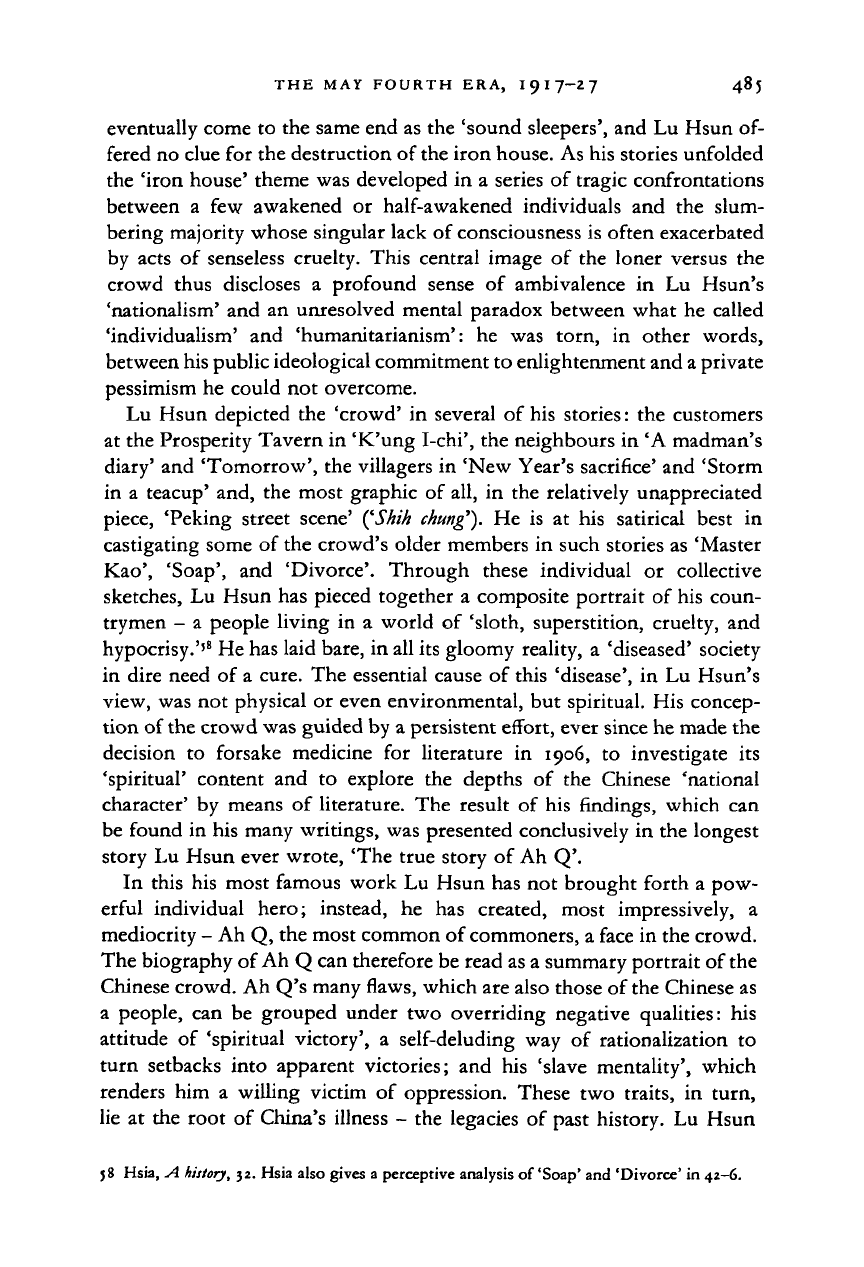
THE MAY FOURTH ERA, I 9 I 7-2 7 485
eventually come to the same end as the 'sound sleepers', and Lu Hsun of-
fered no clue for the destruction of the iron house. As his stories unfolded
the 'iron house' theme was developed in a series of tragic confrontations
between a few awakened or half-awakened individuals and the slum-
bering majority whose singular lack of consciousness is often exacerbated
by acts of senseless cruelty. This central image of the loner versus the
crowd thus discloses a profound sense of ambivalence in Lu Hsun's
'nationalism' and an unresolved mental paradox between what he called
'individualism' and 'humanitarianism': he was torn, in other words,
between his public ideological commitment to enlightenment and a private
pessimism he could not overcome.
Lu Hsun depicted the 'crowd' in several of his stories: the customers
at the Prosperity Tavern in 'K'ung I-chi', the neighbours in 'A madman's
diary' and 'Tomorrow', the villagers in 'New Year's sacrifice' and 'Storm
in a teacup' and, the most graphic of all, in the relatively unappreciated
piece, 'Peking street scene'
i^Shih
chung').
He is at his satirical best in
castigating some of the crowd's older members in such stories as 'Master
Kao',
'Soap', and 'Divorce'. Through these individual or collective
sketches, Lu Hsun has pieced together a composite portrait of his coun-
trymen - a people living in a world of 'sloth, superstition, cruelty, and
hypocrisy.''
8
He has laid bare, in all its gloomy reality, a 'diseased' society
in dire need of a cure. The essential cause of this 'disease', in Lu Hsun's
view, was not physical or even environmental, but spiritual. His concep-
tion of the crowd was guided by a persistent effort, ever since he made the
decision to forsake medicine for literature in 1906, to investigate its
'spiritual' content and to explore the depths of the Chinese 'national
character' by means of literature. The result of his findings, which can
be found in his many writings, was presented conclusively in the longest
story Lu Hsun ever wrote, 'The true story of Ah Q'.
In this his most famous work Lu Hsun has not brought forth a pow-
erful individual hero; instead, he has created, most impressively, a
mediocrity - Ah Q, the most common of commoners, a face in the crowd.
The biography of Ah Q can therefore be read as a summary portrait of the
Chinese crowd. Ah Q's many flaws, which are also those of the Chinese as
a people, can be grouped under two overriding negative qualities: his
attitude of 'spiritual victory', a self-deluding way of rationalization to
turn setbacks into apparent victories; and his 'slave mentality', which
renders him a willing victim of oppression. These two traits, in turn,
lie at the root of China's illness - the legacies of past history. Lu Hsun
58 Hsia, A
history,
32. Hsia also gives a perceptive analysis of'Soap' and 'Divorce' in 42-6.
Cambridge Histories Online © Cambridge University Press, 2008
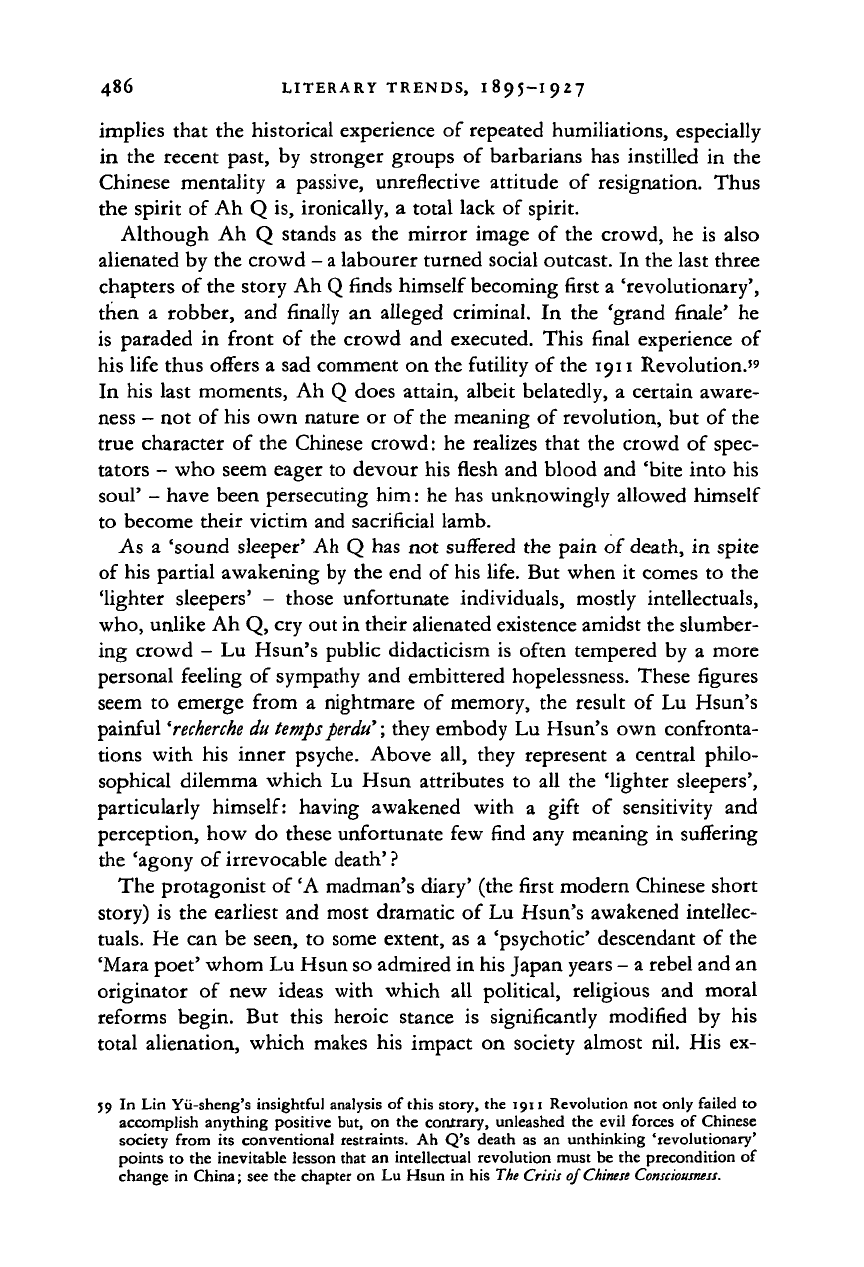
486 LITERARY TRENDS, 1895-I927
implies that the historical experience
of
repeated humiliations, especially
in
the
recent past,
by
stronger groups
of
barbarians has instilled
in the
Chinese mentality
a
passive, unreflective attitude
of
resignation. Thus
the spirit
of
Ah
Q
is, ironically,
a
total lack
of
spirit.
Although
Ah Q
stands
as the
mirror image
of
the crowd,
he is
also
alienated by the crowd
-
a
labourer turned social outcast.
In
the last three
chapters
of
the story Ah Q finds himself becoming first
a
'revolutionary',
then
a
robber,
and
finally
an
alleged criminal.
In the
'grand finale'
he
is paraded
in
front
of
the crowd and executed. This final experience
of
his life thus offers
a
sad comment on the futility
of
the 1911 Revolution."
In his last moments, Ah
Q
does attain, albeit belatedly,
a
certain aware-
ness
-
not
of
his own nature
or of
the meaning
of
revolution, but
of
the
true character
of
the Chinese crowd:
he
realizes that the crowd
of
spec-
tators
-
who seem eager to devour his flesh and blood and 'bite into his
soul'
-
have been persecuting him:
he
has unknowingly allowed himself
to become their victim and sacrificial lamb.
As
a
'sound sleeper' Ah
Q
has not suffered the pain
of
death,
in
spite
of his partial awakening by the end
of
his life. But when
it
comes
to
the
'lighter sleepers'
-
those unfortunate individuals, mostly intellectuals,
who,
unlike Ah Q, cry out in their alienated existence amidst the slumber-
ing crowd
—
Lu
Hsun's public didacticism
is
often tempered
by a
more
personal feeling
of
sympathy and embittered hopelessness. These figures
seem
to
emerge from
a
nightmare
of
memory,
the
result
of
Lu Hsun's
painful
'recherche
du temps perdu'; they embody Lu Hsun's own confronta-
tions with
his
inner psyche. Above all, they represent
a
central philo-
sophical dilemma which Lu Hsun attributes
to all the
'lighter sleepers',
particularly
himself:
having awakened with
a
gift
of
sensitivity
and
perception, how
do
these unfortunate
few
find any meaning
in
suffering
the 'agony
of
irrevocable death'
?
The protagonist
of
'A madman's diary' (the first modern Chinese short
story)
is
the earliest and most dramatic
of
Lu Hsun's awakened intellec-
tuals.
He
can be seen,
to
some extent,
as a
'psychotic' descendant
of
the
'Mara poet' whom Lu Hsun so admired in his Japan years
-
a rebel and an
originator
of new
ideas with which
all
political, religious
and
moral
reforms begin.
But
this heroic stance
is
significantly modified
by his
total alienation, which makes
his
impact
on
society almost nil.
His ex-
59
In
Lin Yii-sheng's insightful analysis of this story, the 1911 Revolution not only failed
to
accomplish anything positive but,
on the
contrary, unleashed the evil forces
of
Chinese
society from
its
conventional restraints.
Ah Q's
death
as an
unthinking 'revolutionary'
points
to
the inevitable lesson that an intellectual revolution must be the precondition of
change
in
China; see the chapter on Lu Hsun
in
his
The Crisis
of
Chinese
Consciousness.
Cambridge Histories Online © Cambridge University Press, 2008
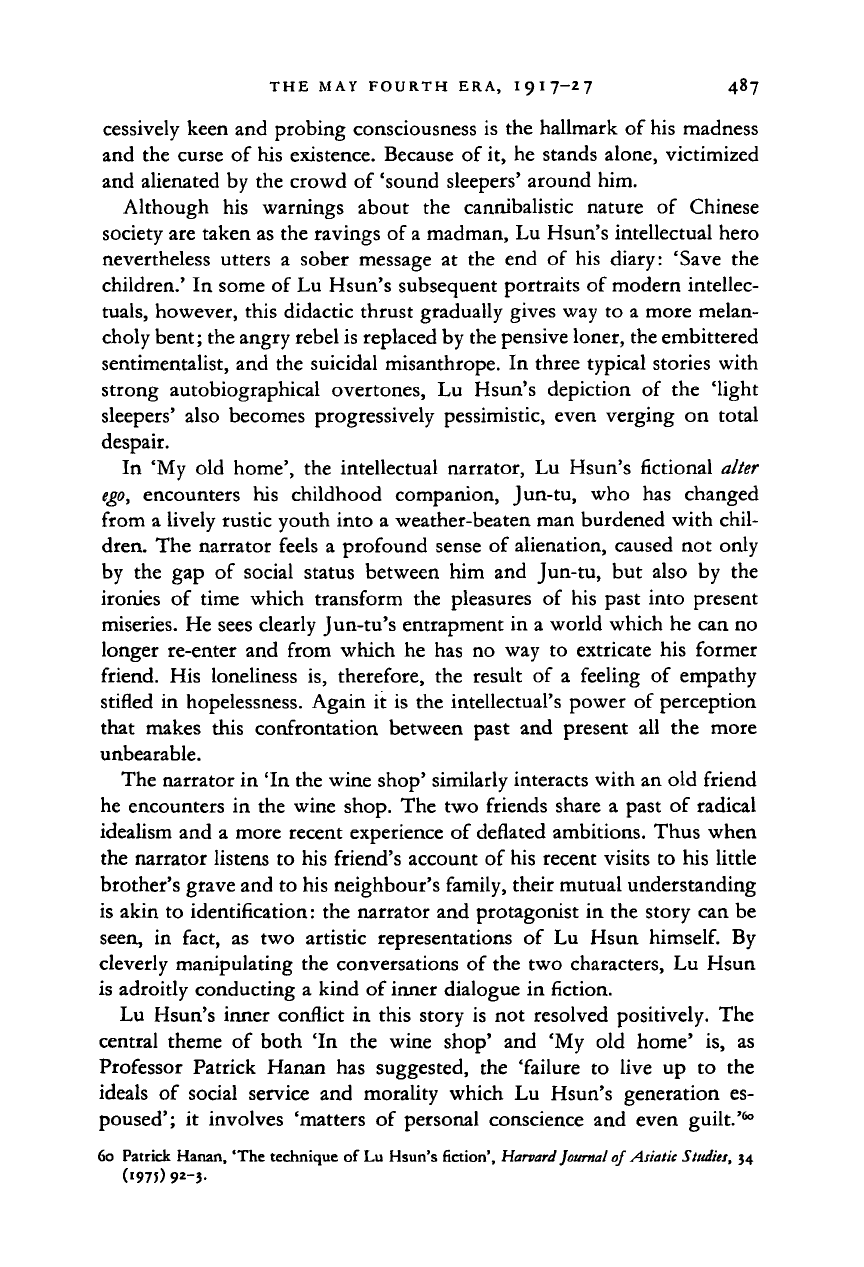
THE MAY FOURTH ERA, I 9 I 7-2 7 487
cessively keen and probing consciousness is the hallmark of his madness
and the curse of his existence. Because of it, he stands alone, victimized
and alienated by the crowd of 'sound sleepers' around him.
Although his warnings about the cannibalistic nature of Chinese
society are taken as the ravings of a madman, Lu Hsun's intellectual hero
nevertheless utters a sober message at the end of his diary: 'Save the
children.' In some of Lu Hsun's subsequent portraits of modern intellec-
tuals,
however, this didactic thrust gradually gives way to a more melan-
choly bent; the angry rebel is replaced by the pensive loner, the embittered
sentimentalist, and the suicidal misanthrope. In three typical stories with
strong autobiographical overtones, Lu Hsun's depiction of the 'light
sleepers' also becomes progressively pessimistic, even verging on total
despair.
In 'My old home', the intellectual narrator, Lu Hsun's fictional alter
ego,
encounters his childhood companion, Jun-tu, who has changed
from a lively rustic youth into a weather-beaten man burdened with chil-
dren. The narrator feels a profound sense of alienation, caused not only
by the gap of social status between him and Jun-tu, but also by the
ironies of time which transform the pleasures of his past into present
miseries. He sees clearly Jun-tu's entrapment in a world which he can no
longer re-enter and from which he has no way to extricate his former
friend. His loneliness is, therefore, the result of a feeling of empathy
stifled in hopelessness. Again it is the intellectual's power of perception
that makes this confrontation between past and present all the more
unbearable.
The narrator in 'In the wine shop' similarly interacts with an old friend
he encounters in the wine shop. The two friends share a past of radical
idealism and a more recent experience of deflated ambitions. Thus when
the narrator listens to his friend's account of his recent visits to his little
brother's grave and to his neighbour's family, their mutual understanding
is akin to identification: the narrator and protagonist in the story can be
seen, in fact, as two artistic representations of Lu Hsun
himself.
By
cleverly manipulating the conversations of the two characters, Lu Hsun
is adroitly conducting a kind of inner dialogue in fiction.
Lu Hsun's inner conflict in this story is not resolved positively. The
central theme of both 'In the wine shop' and 'My old home' is, as
Professor Patrick Hanan has suggested, the 'failure to live up to the
ideals of social service and morality which Lu Hsun's generation es-
poused'; it involves 'matters of personal conscience and even guilt.'
60
60 Patrick Hanan, 'The technique of Lu Hsun's fiction',
Harvard
journal of Asiatic Studies, 34
(•975) 9
2
~3-
Cambridge Histories Online © Cambridge University Press, 2008
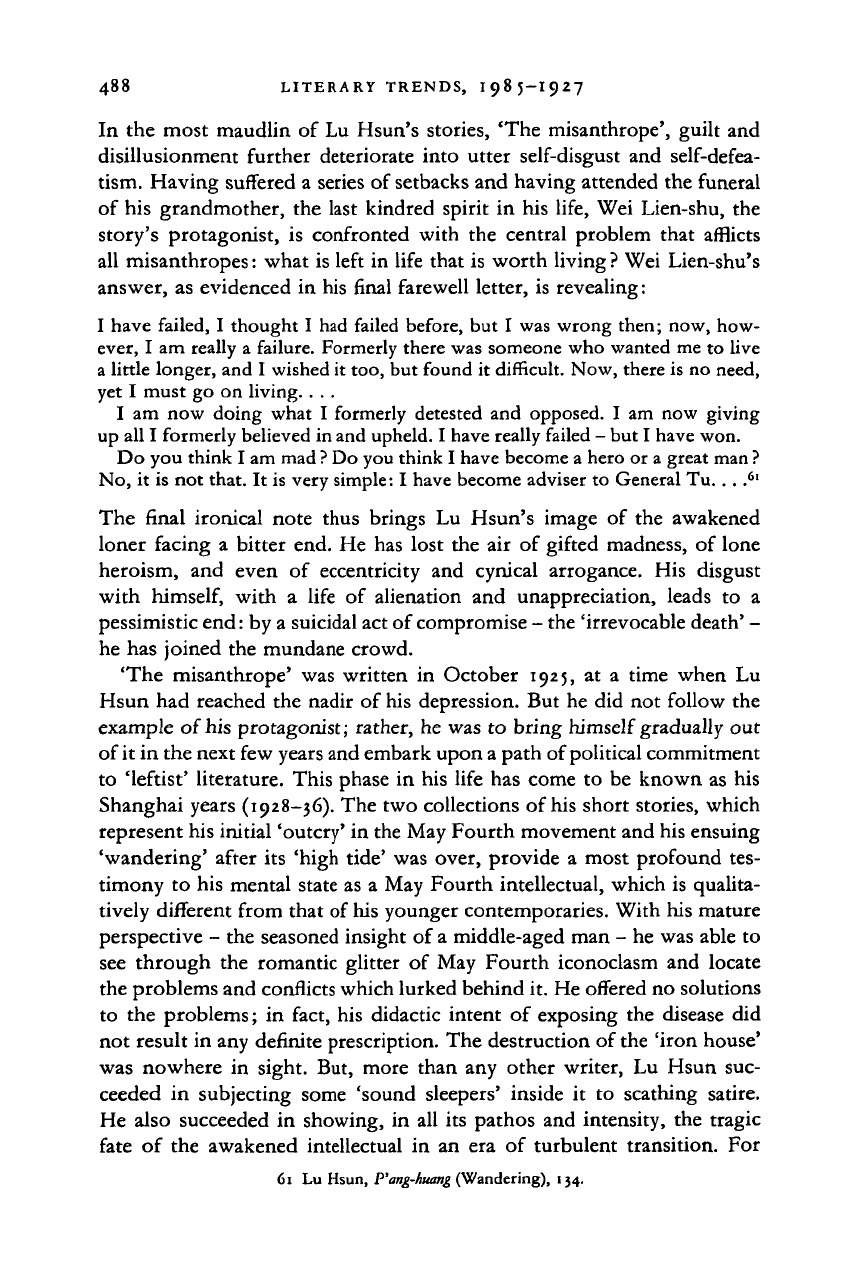
488 LITERARY TRENDS, I985-I927
In the most maudlin
of
Lu Hsun's stories, 'The misanthrope', guilt and
disillusionment further deteriorate into utter self-disgust and self-defea-
tism. Having suffered a series of setbacks and having attended the funeral
of his grandmother, the last kindred spirit
in
his life, Wei Lien-shu, the
story's protagonist,
is
confronted with the central problem that afflicts
all misanthropes: what is left in life that is worth living
?
Wei Lien-shu's
answer, as evidenced in his final farewell letter, is revealing:
I have failed,
I
thought
I
had failed before, but
I
was wrong then; now, how-
ever,
I
am really a failure. Formerly there was someone who wanted me to live
a little longer, and I wished it too, but found it difficult. Now, there is no need,
yet
I
must go on living. . .
.
I am now doing what
I
formerly detested and opposed.
I
am now giving
up all I formerly believed in and upheld.
I
have really failed
-
but I have won.
Do you think I am mad
?
Do you think I have become
a
hero or a great
man ?
No,
it is not that. It is very
simple:
I
have become adviser to General Tu. . . .
6l
The final ironical note thus brings
Lu
Hsun's image
of
the awakened
loner facing
a
bitter end. He has lost the air
of
gifted madness,
of
lone
heroism,
and
even
of
eccentricity
and
cynical arrogance.
His
disgust
with
himself,
with
a
life
of
alienation and unappreciation, leads
to a
pessimistic end: by a suicidal act of compromise
-
the 'irrevocable death'
-
he has joined the mundane crowd.
'The misanthrope' was written
in
October 1925,
at a
time when
Lu
Hsun had reached the nadir of his depression. But he did not follow the
example of his protagonist; rather, he was to bring himself gradually out
of it in the next few years and embark upon a path of political commitment
to 'leftist' literature. This phase in his life has come
to
be known as his
Shanghai years (1928-36). The two collections of his short stories, which
represent his initial 'outcry' in the May Fourth movement and his ensuing
'wandering' after its 'high tide' was over, provide
a
most profound tes-
timony to his mental state as
a
May Fourth intellectual, which is qualita-
tively different from that of his younger contemporaries. With his mature
perspective
-
the seasoned insight of a middle-aged man
-
he was able to
see through the romantic glitter
of
May Fourth iconodasm and locate
the problems and conflicts which lurked behind it. He offered no solutions
to the problems;
in
fact, his didactic intent
of
exposing the disease did
not result in any definite prescription. The destruction of the 'iron house'
was nowhere
in
sight. But, more than any other writer,
Lu
Hsun suc-
ceeded
in
subjecting some 'sound sleepers' inside
it to
scathing satire.
He also succeeded
in
showing,
in
all its pathos and intensity, the tragic
fate
of
the awakened intellectual
in an
era
of
turbulent transition.
For
61 Lu Hsun,
P'ang-huang
(Wandering), 134.
Cambridge Histories Online © Cambridge University Press, 2008
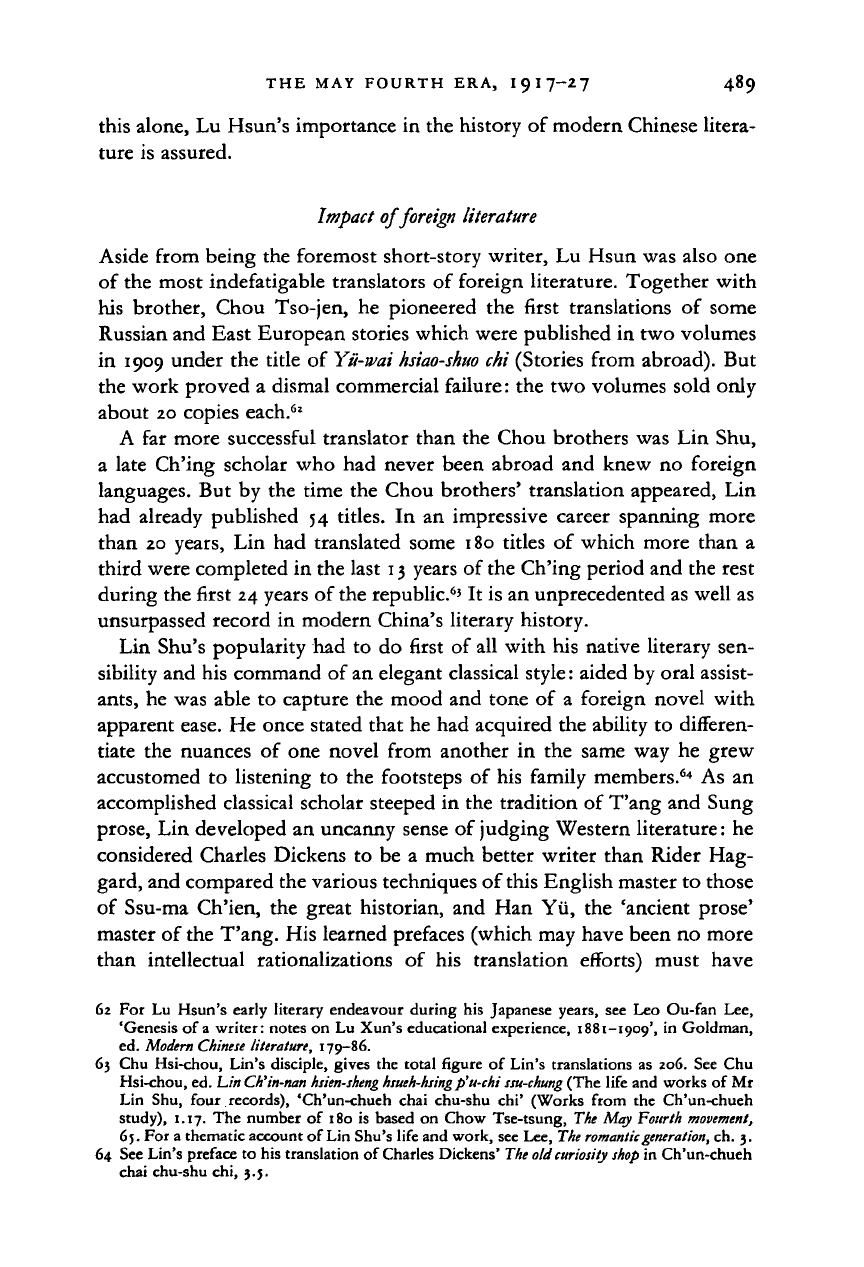
THE MAY FOURTH ERA, I 9 I 7-2 7 489
this alone, Lu Hsun's importance in the history of modern Chinese litera-
ture is assured.
Impact of foreign literature
Aside from being the foremost short-story writer, Lu Hsun was also one
of the most indefatigable translators of foreign literature. Together with
his brother, Chou Tso-jen, he pioneered the first translations of some
Russian and East European stories which were published in two volumes
in 1909 under the title of
Yu-wai hsiao-shuo chi
(Stories from abroad). But
the work proved a dismal commercial failure: the two volumes sold only
about 20 copies each.
62
A far more successful translator than the Chou brothers was Lin Shu,
a late Ch'ing scholar who had never been abroad and knew no foreign
languages. But by the time the Chou brothers' translation appeared, Lin
had already published 54 titles. In an impressive career spanning more
than 20 years, Lin had translated some 180 titles of which more than a
third were completed in the last 13 years of the Ch'ing period and the rest
during the first 24 years of the republic.
6
' It is an unprecedented as well as
unsurpassed record in modern China's literary history.
Lin Shu's popularity had to do first of all with his native literary sen-
sibility and his command of an elegant classical style: aided by oral assist-
ants,
he was able to capture the mood and tone of a foreign novel with
apparent ease. He once stated that he had acquired the ability to differen-
tiate the nuances of one novel from another in the same way he grew
accustomed to listening to the footsteps of his family members.
64
As an
accomplished classical scholar steeped in the tradition of T'ang and Sung
prose, Lin developed an uncanny sense of judging Western literature: he
considered Charles Dickens to be a much better writer than Rider Hag-
gard, and compared the various techniques of this English master to those
of Ssu-ma Ch'ien, the great historian, and Han Yii, the 'ancient prose'
master of the T'ang. His learned prefaces (which may have been no more
than intellectual rationalizations of his translation efforts) must have
62 For Lu Hsun's early literary endeavour during his Japanese years, see Leo Ou-fan Lee,
'Genesis of
a
writer: notes on Lu Xun's educational experience, 1881-1909', in Goldman,
ed.
Modern Chinese
literature,
179—86.
63 Chu Hsi-chou, Lin's disciple, gives the total figure of Lin's translations as 206. See Chu
Hsi-chou, ed. Lin
Ch'in-nan hsien-sheng hsueh-hsingp'u-chi ssu-chung
(The life and works of Mr
Lin Shu, four records), 'Ch'un-chueh chai chu-shu chi' (Works from the Ch'un-chueh
study), 1.17. The number of 180 is based on Chow Tse-tsung, The May Fourth
movement,
65.
For a thematic account of Lin Shu's life and work, see Lee,
The
romantic
generation,
ch. 3.
64 See Lin's preface to his translation of Charles Dickens'
The
old
curiosity shop
in Ch'un-chueh
chai chu-shu chi, 3.5.
Cambridge Histories Online © Cambridge University Press, 2008
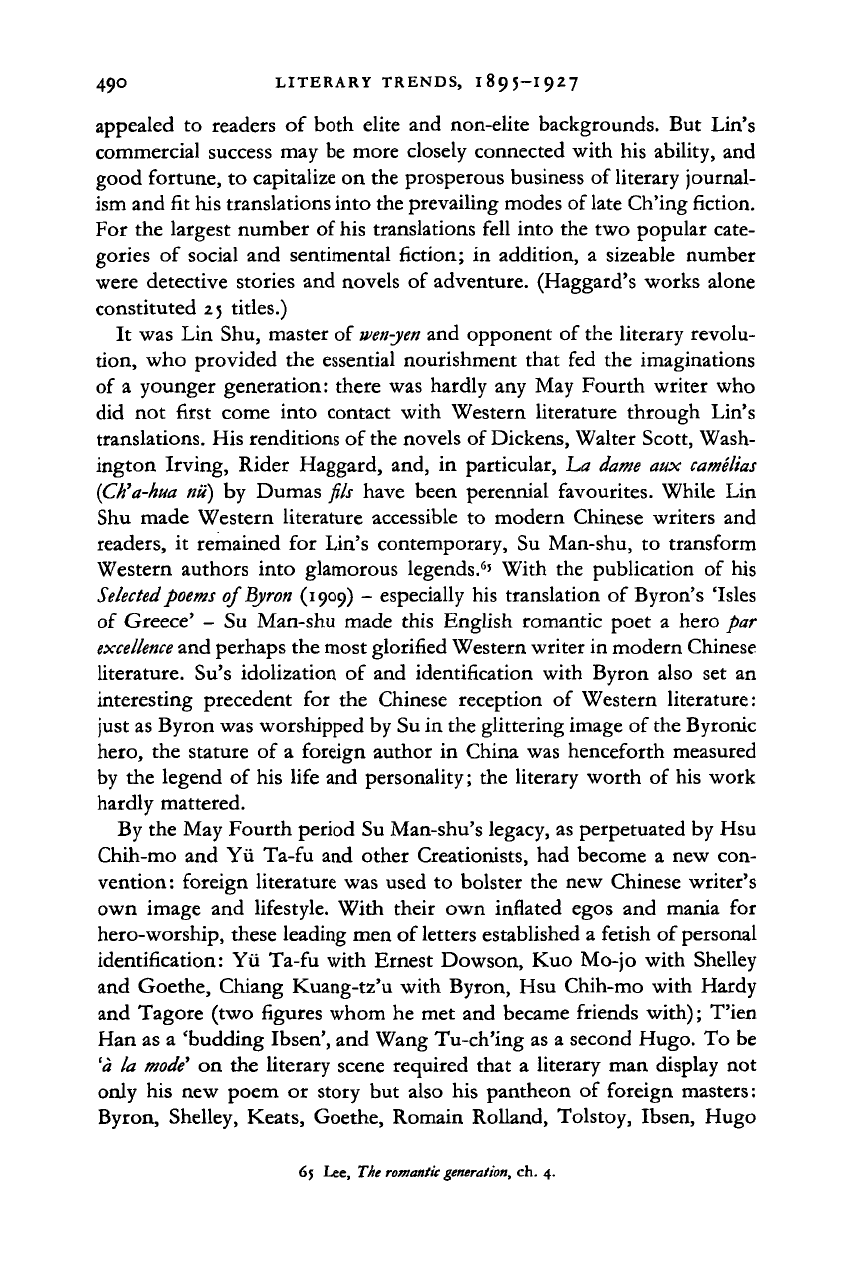
490 LITERARY TRENDS, 1895-1927
appealed
to
readers
of
both elite and non-elite backgrounds. But Lin's
commercial success may be more closely connected with his ability, and
good fortune, to capitalize on the prosperous business of literary journal-
ism and
fit
his translations into the prevailing modes of
late
Ch'ing fiction.
For the largest number of his translations fell into the two popular cate-
gories
of
social and sentimental fiction;
in
addition,
a
sizeable number
were detective stories and novels of adventure. (Haggard's works alone
constituted 25 titles.)
It was Lin Shu, master of
wen-yen
and opponent of the literary revolu-
tion, who provided the essential nourishment that fed the imaginations
of
a
younger generation: there was hardly any May Fourth writer who
did
not
first come into contact with Western literature through Lin's
translations. His renditions of the novels of Dickens, Walter Scott, Wash-
ington Irving, Rider Haggard, and,
in
particular,
ha
dame
aux
camelias
(Cn'a-hua
nu)
by
Dumas fils have been perennial favourites. While Lin
Shu made Western literature accessible
to
modern Chinese writers and
readers,
it
remained
for
Lin's contemporary, Su Man-shu,
to
transform
Western authors into glamorous legends.
6
' With the publication
of
his
Selected poems of
Byron
(1909)
-
especially his translation
of
Byron's 'Isles
of Greece'
- Su
Man-shu made this English romantic poet
a
hero par
excellence
and perhaps the most glorified Western writer in modern Chinese
literature. Su's idolization
of
and identification with Byron also set
an
interesting precedent
for
the Chinese reception
of
Western literature:
just as Byron was worshipped by Su in the glittering image of the Byronic
hero,
the stature
of a
foreign author
in
China was henceforth measured
by the legend
of
his life and personality; the literary worth
of
his work
hardly mattered.
By the May Fourth period Su Man-shu's legacy, as perpetuated by Hsu
Chih-mo and Yii Ta-fu and other Creationists, had become
a
new con-
vention: foreign literature was used
to
bolster the new Chinese writer's
own image and lifestyle. With their own inflated egos and mania
for
hero-worship, these leading men of letters established
a
fetish of personal
identification: Yii Ta-fu with Ernest Dowson, Kuo Mo-jo with Shelley
and Goethe, Chiang Kuang-tz'u with Byron, Hsu Chih-mo with Hardy
and Tagore (two figures whom he met and became friends with); T'ien
Han as
a
'budding Ibsen', and Wang Tu-ch'ing as
a
second Hugo. To be
'a la
mode"
on the literary scene required that
a
literary man display not
only his new poem
or
story but also his pantheon
of
foreign masters:
Byron, Shelley, Keats, Goethe, Romain Rolland, Tolstoy, Ibsen, Hugo
65 Lee, The
romantic
generation,
ch.
4.
Cambridge Histories Online © Cambridge University Press, 2008
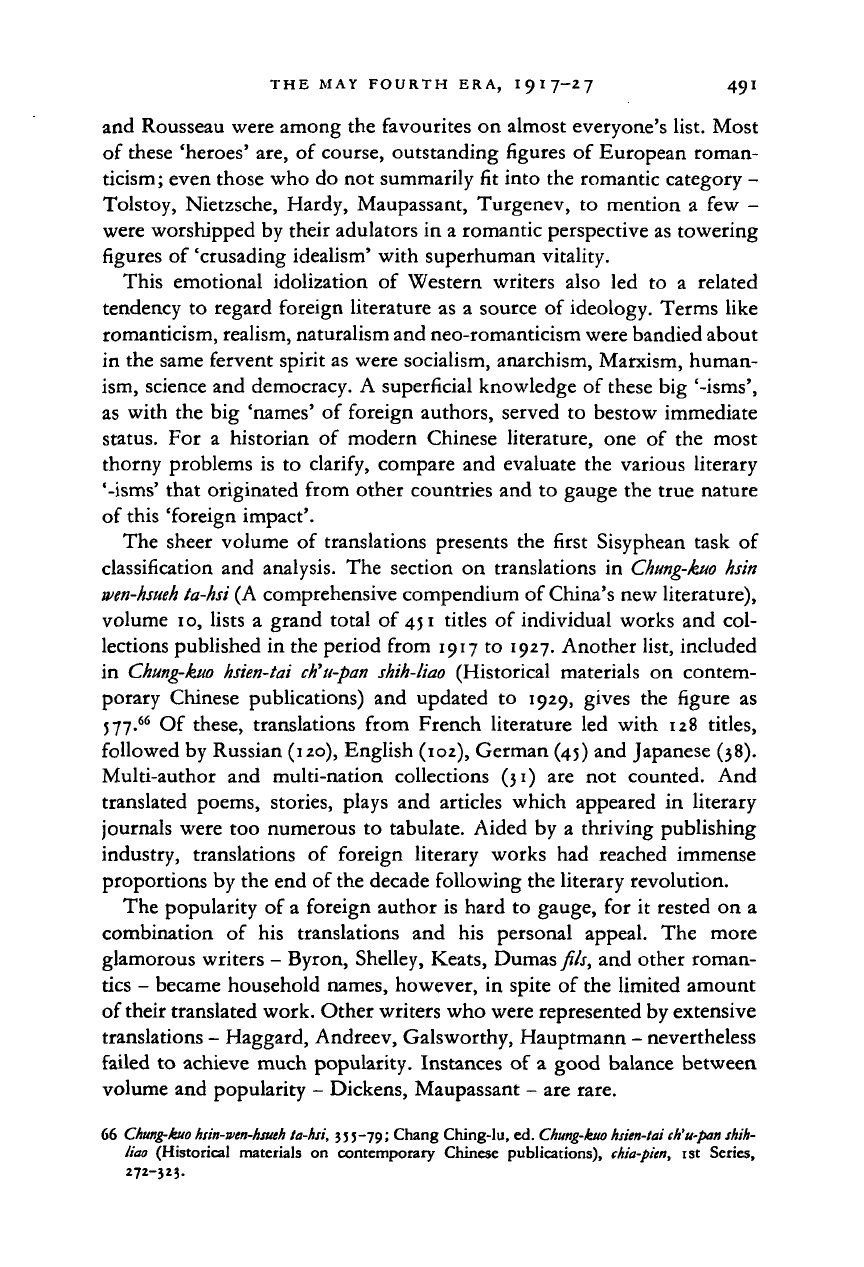
THE MAY FOURTH ERA, I 9 I 7-2 7 491
and Rousseau were among the favourites on almost everyone's list. Most
of these 'heroes' are, of course, outstanding figures of European roman-
ticism; even those who do not summarily fit into the romantic category -
Tolstoy, Nietzsche, Hardy, Maupassant, Turgenev, to mention a few -
were worshipped by their adulators in a romantic perspective as towering
figures of 'crusading idealism' with superhuman vitality.
This emotional idolization of Western writers also led to a related
tendency to regard foreign literature as a source of ideology. Terms like
romanticism, realism, naturalism and neo-romanticism were bandied about
in the same fervent spirit as were socialism, anarchism, Marxism, human-
ism, science and democracy. A superficial knowledge of these big '-isms',
as with the big 'names' of foreign authors, served to bestow immediate
status.
For a historian of modern Chinese literature, one of the most
thorny problems is to clarify, compare and evaluate the various literary
'-isms'
that originated from other countries and to gauge the true nature
of this 'foreign impact'.
The sheer volume of translations presents the first Sisyphean task of
classification and analysis. The section on translations in
Chung-kuo
hsin
wen-hsueh ta-hsi
(A comprehensive compendium of China's new literature),
volume 10, lists a grand total of
451
titles of individual works and col-
lections published in the period from 1917 to 1927. Another list, included
in Chung-kuo hsien-tai cKu-pan shih-liao (Historical materials on contem-
porary Chinese publications) and updated to 1929, gives the figure as
577-
66
Of these, translations from French literature led with 128 titles,
followed by Russian (120), English (102), German (45) and Japanese (38).
Multi-author and multi-nation collections (31) are not counted. And
translated poems, stories, plays and articles which appeared in literary
journals were too numerous to tabulate. Aided by a thriving publishing
industry, translations of foreign literary works had reached immense
proportions by the end of the decade following the literary revolution.
The popularity of a foreign author is hard to gauge, for it rested on a
combination of his translations and his personal appeal. The more
glamorous writers - Byron, Shelley, Keats, Dumas fils, and other roman-
tics - became household names, however, in spite of the limited amount
of their translated work. Other writers who were represented by extensive
translations - Haggard, Andreev, Galsworthy, Hauptmann - nevertheless
failed to achieve much popularity. Instances of a good balance between
volume and popularity - Dickens, Maupassant - are rare.
66 Chung-kuo hsin-wen-hsuch ta-hsi,
3 5
5-79; Chang Ching-lu, ed. Chung-kuo hsien-tai ch'u-pan shih-
liao (Historical materials on contemporary Chinese publications), chia-picn, 1st Series,
272-323.
Cambridge Histories Online © Cambridge University Press, 2008

492 LITERARY TRENDS, 1895-I927
The lists
of
translations encompassed authors from more than
20
countries and different historical periods. In general, however, the over-
whelming majority of the works introduced belong to nineteenth-century
European literature,
of
which two major trends held sway
in
China:
realism and romanticism.
From the viewpoint of literary history
it
can be said that the mania in
China for things Western represented a zestful effort to squeeze the entire
nineteenth century into one decade. Almost all the May Fourth writers
were scornful of Western classicism, because in their iconoclastic fervour
they equated classicism with tradition. Only Chou Tso-jen professed an
interest in the Hellenistic heritage. And only a handful of Chinese critics
-
most
of
them disciples of Irving Babbitt
-
seemed
to
share the views of
Matthew Arnold. Of the pre-nineteenth-century authors, only Aristotle,
Dante, Shakespeare and Goethe enjoyed some degree
of
recognition.
67
And what came to be known as 'modernism', which emerged in Europe
following
the
First World War,
did not
interest
the
Chinese men
of
letters until the 1930s and 1940s
-
and then only a small coterie of writers
and critics.
The main reason
for
this phenomenon may be traced
to a
prevalent
conception
of
literary evolution.
As
Bonnie McDougall has shown
in
her valuable study
of
the introduction
of
Western literary theories into
China, the Chinese writers, influenced by
a
host of textbooks in English
and Japanese, apparently believed that European literature developed
organically through the stages of classicism, romanticism, realism, natural-
ism and neo-romanticism.
68
While this scheme is not a gross misrepresen-
tation
of
European literary history,
the
Chinese cast
it as a
progressive
sequence of literary evolution: new forms were believed to be
a
definite
improvement
on
the old. This conviction
of
the forward progress
of
literature led many Chinese followers not only to a general lack of interest
in the classical, medieval and neo-classical literatures of the West but also
to
an
over-eagerness
to
compress modern Chinese literature into these
deterministic categories. Convinced that traditional Chinese literature
stopped somewhere between the stages
of
classicism and romanticism,
they decided that modern Chinese literature had to go through the stages
of realism and naturalism, whether
or not
they might
be
personally
attracted to them.
This evolutionary commitment to realism, in spite of a romantic temper,
67 Bonnie
S.
McDougall, The
introduction
of
Western literary
theories
into
modern
China, 1919-
if2f,
256. For a study of Chou Tso-jen's interest in ancient Greek culture, see C. H. Wang,
'Chou Tso-jen's Hellenism',
Renditions
7 (Spring 1977) 5-28.
68 McDougall, 254-5.
Cambridge Histories Online © Cambridge University Press, 2008
